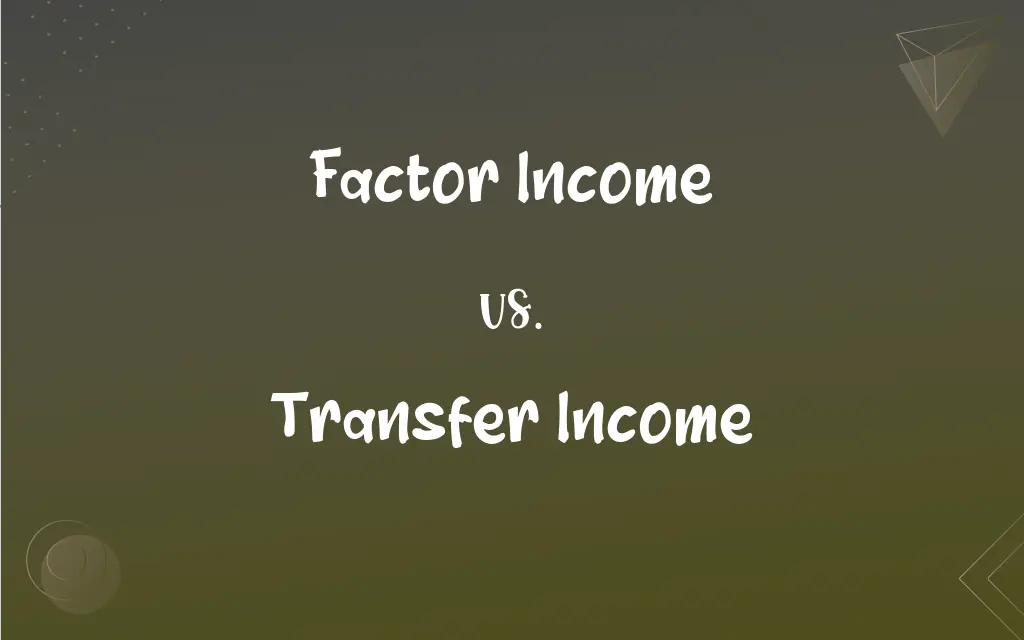Factor Income vs. Transfer Income: What's the Difference?
Edited by Aimie Carlson || By Janet White || Published on November 23, 2023
Factor income is earned from production factors like labor and capital, while transfer income is received without providing goods or services, like pensions.

Key Differences
Factor income and transfer income are two different concepts in economics, each with distinct characteristics and sources. Factor income is the income derived from the factors of production, namely land, labor, capital, and entrepreneurship, in the production process. In contrast, transfer income refers to payments made without any exchange of goods or services, such as pensions, grants, and welfare benefits.
Factor income includes wages earned by labor, rent earned by landowners, interest on capital, and profits for entrepreneurs. These incomes are a result of active participation in the production process. Transfer income, on the other hand, does not result from economic production or the provision of services. Instead, it represents redistribution of income, often by the government, from one segment of the economy to another.
The primary source of factor income is the productive use of resources in an economy. It is a reward for contributing to the production process, like employees receiving wages for their work. Transfer income, however, stems from social welfare policies or other redistributive mechanisms, and is not linked to the recipient’s contribution to production. For example, unemployment benefits are a form of transfer income provided to individuals without them having to provide labor in return.
Factor income is a crucial part of national income accounting, representing the sum of all incomes earned through the production of goods and services. Transfer income, conversely, is not included in the calculation of a nation’s productive output (GDP), as it simply redistributes income within the economy. Social security payments are a typical example of transfer income, not reflecting any direct contribution to economic output.
In terms of economic impact, factor income is directly linked to productivity and economic growth, as it incentivizes the use of resources. Transfer income, while not directly contributing to economic production, plays a vital role in social welfare and income redistribution. It helps in reducing income inequality and providing a safety net for the less fortunate, but does not directly contribute to the production of goods and services in an economy.
ADVERTISEMENT
Comparison Chart
Source
Labor, capital, land, entrepreneurship
Government programs, pensions, welfare benefits
Economic Contribution
Directly contributes to production
Redistribution of income, no direct contribution
Inclusion in GDP
Yes, as it reflects economic productivity
No, as it doesn’t result from current production
Nature
Compensation for economic inputs and services
Payments without a direct service or product
Examples
Wages, rent, interest, profits
Social security, grants, subsidies
ADVERTISEMENT
Factor Income and Transfer Income Definitions
Factor Income
Income earned from the use of production factors like labor or capital.
His factor income included earnings from his job and rental properties.
Transfer Income
Income received without a direct exchange of goods or services.
Her pension was a major source of transfer income after retirement.
Factor Income
Economic returns from active involvement in production processes.
His investments in the stock market increased his factor income substantially.
Transfer Income
Payments from social programs or redistribution efforts.
The family's transfer income included child welfare benefits.
Factor Income
Compensation received for providing labor, capital, or resources.
As an artist, her paintings contributed significantly to her factor income.
Transfer Income
Non-production-related income like subsidies, grants, or pensions.
The agricultural subsidy contributed to the farmer's transfer income.
Factor Income
Earnings from contributing to economic production and activities.
The company's factor income was a mix of profits and interest income.
Transfer Income
Financial support received from government or charitable sources.
His transfer income included a government grant for education.
Factor Income
Income generated through direct economic contributions and services.
The factory owner's factor income comprised profits from sales and machinery rent.
Transfer Income
Income derived without directly contributing to economic production.
Disability benefits formed a part of her transfer income.
FAQs
Are salaries considered factor income?
Yes, salaries are a form of factor income earned from labor.
Is social security a transfer income?
Yes, social security is a common type of transfer income.
Can transfer income be from private sources?
Yes, it can come from private sources like insurance payouts or private pensions.
What is transfer income?
It's income received without a direct contribution to production, like pensions or subsidies.
Is rent considered factor income?
Yes, rent is factor income earned from providing property resources.
What's an example of factor income?
Earnings from a job or interest from investments.
How does factor income affect the economy?
It reflects the economic productivity and is crucial for economic growth.
Can businesses have factor income?
Yes, businesses earn factor income through profits and other economic activities.
What is factor income?
It's income earned from contributing to production, like wages, rent, or profits.
Does factor income contribute to GDP?
Yes, it directly contributes to GDP through productive activities.
Are unemployment benefits transfer income?
Yes, unemployment benefits are a type of transfer income.
What role does transfer income play in society?
It helps in wealth redistribution and supports individuals financially.
Do dividends count as factor income?
Yes, dividends are factor income earned from capital investments.
Can transfer income be taxed?
Yes, depending on the country’s tax laws, some transfer incomes may be taxable.
Does transfer income always come from the government?
No, it can also come from private sources like charities or insurance companies.
Is transfer income included in GDP calculations?
No, it's not included in GDP as it doesn't result from current production.
Is inheritance considered transfer income?
Generally, inheritance is classified as transfer income.
Who typically receives transfer income?
Individuals receiving government benefits, pensions, or grants.
How is factor income calculated?
It's calculated by summing up all earnings from labor, capital, land, and entrepreneurship.
Can factor income fluctuate?
Yes, it can fluctuate based on economic conditions and personal productivity.
About Author
Written by
Janet WhiteJanet White has been an esteemed writer and blogger for Difference Wiki. Holding a Master's degree in Science and Medical Journalism from the prestigious Boston University, she has consistently demonstrated her expertise and passion for her field. When she's not immersed in her work, Janet relishes her time exercising, delving into a good book, and cherishing moments with friends and family.
Edited by
Aimie CarlsonAimie Carlson, holding a master's degree in English literature, is a fervent English language enthusiast. She lends her writing talents to Difference Wiki, a prominent website that specializes in comparisons, offering readers insightful analyses that both captivate and inform.































































